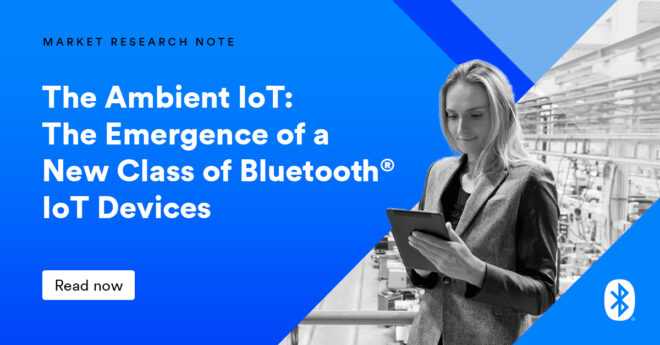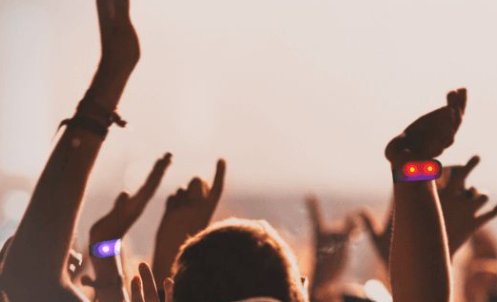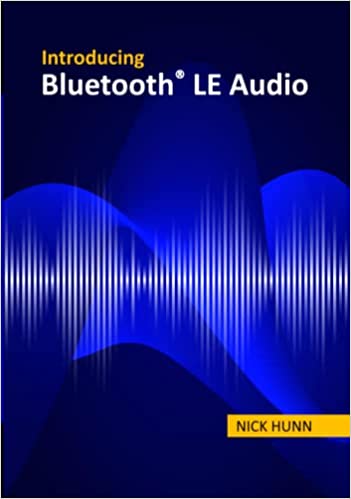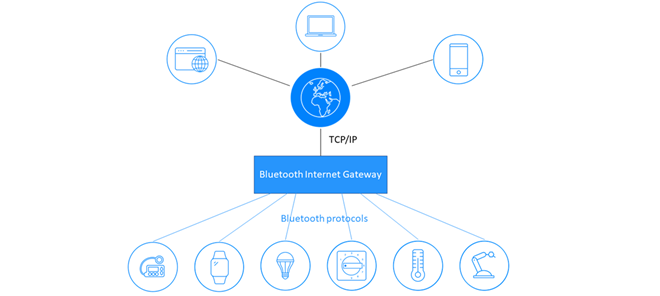A globally recognized standards body, the Bluetooth Special Interest Group (SIG) supports industry-leading companies around the globe in specification development, device qualification testing, and promotion of Bluetooth® technology. A not-for-profit trade association with more than 40,000 member companies, the Bluetooth SIG works with members to advance Bluetooth technology across a wide range of markets and solutions.
Each year, Bluetooth member companies ship more than five billion Bluetooth enabled products worldwide, with continued growth forecasted for the foreseeable future. By 2027, Bluetooth member companies are expected to ship 7.6 billion Bluetooth enable products each year, a nine percent compound annual growth rate (CAGR).
Key emerging use cases for Bluetooth technology that will have major market impacts include Auracast™ broadcast audio, electronic shelf labels (ESL), and Ambient IoT.
Auracast™ Broadcast Audio
For more than 20 years, Bluetooth® technology has enabled a wide range of wireless audio innovation, revolutionizing audio and changing the way we consume media and experience the world. Bluetooth LE Audio is a new, flexible Bluetooth architecture that will support the next 20 years of audio innovation. Bluetooth LE Audio will bring a number of initial enhancements to help relieve some of the challenges seen in the market today, including:
- Better performing products (higher quality, better performance, and lower power)
- Greater availability of Bluetooth hearing aids, with new standardization, increased performance, and global interoperability
- Broadcast audio and the introduction of Auracast™ broadcast audio for public spaces
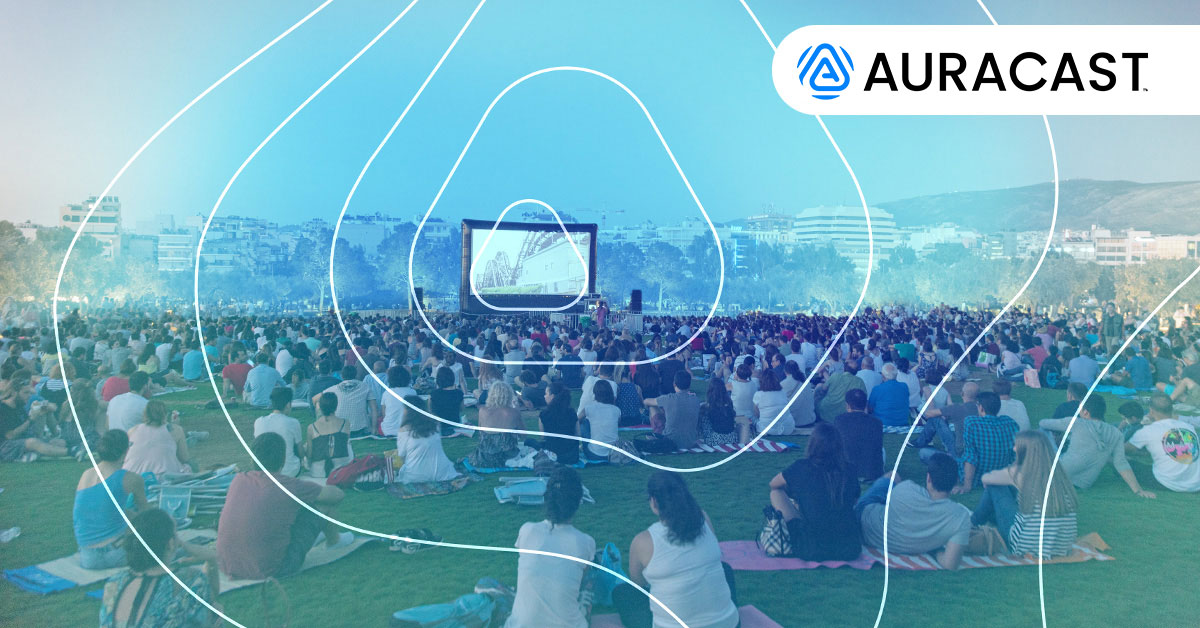
Auracast™ broadcast audio is a new Bluetooth® capability that will deliver game-changing audio experiences to help your world sound better. This is not the traditional Bluetooth paired experience. Auracast™ broadcast audio allows transmitters (phone, tablet, PC, or public transmitter) to broadcast an audio signal to an unlimited number of in-range receivers (earbuds or headphones).
Transmitters can broadcast openly to an unlimited number of listeners, and the smartphone is not needed for you to hear an Auracast™ broadcast. Of course, an Auracast™ broadcast can be secured with a password for encryption, but most audio broadcasts will likely be open to all, especially in public spaces.
When you look at the Auracast™ market story, there are three key experiences it will enable:
- Share Your Audio: With a smartphone, tablet, laptop, or similar devices, you can share your audio experience with others around you, allowing you to listen to music and watch videos together with each person using their own earbuds or headphones. This could also include applications like tour systems and similar group listening experiences where one audio source is transmitting to multiple personal earbuds or headphones.
- Unmute Your World: This experience provides the opportunity for you to listen to the audio of silent TVs seen in bars, gyms, waiting rooms, airports, and other public spaces. Auracast™ broadcast audio will allow you to join the audio broadcast of a program or monitor rather than watching (reading closed caption) in silence.
- Hear Your Best: Overcoming loud ambient noise can be a challenge in public spaces for everyone, and this is especially true for people with hearing loss. Auarcast™ broadcast audio enables direct audio listening to public address systems and other transmitters to help you hear your best using your listening and hearing devices. This includes augmented audio experiences at theaters and assistive listening in public spaces and locations like places of worship, transit centers, airports, conference centers, and other public gathering spaces. This can also include multi-language support, listening to any audio source that provides a simulcast of an alternate language.
Of course, global support for Auracast™ broadcast audio in all public locations will not happen overnight. It will take several years for the market to fully integrate this new audio innovation. However, the estimated uptake and opportunity of Bluetooth LE Audio and the use cases for Auracast™ broadcast audio are quite significant.
ABI Research estimates there will be more than three billion Bluetooth LE Audio-enabled devices shipping each year within the next five years; 90 percent of new smartphones shipped each year for the next five years will include Bluetooth LE Audio. This is consistent with what we saw when the Bluetooth® LE radio first launched, which is now in 100 percent of smartphones.
ABI Research also estimates that more than 61 million establishments globally could benefit from and take advantage of Auracast™ broadcast audio today. And while it is still too early to track trends, analysts forecast that there will roughly be 2.5 million Auracast™ broadcast audio location deployments in the next five-to-seven years. For more details on these and other estimates, please download and review LE Audio: The Future of Bluetooth Audio.
![]()
FEATURED REPORT
The Bluetooth® Market Update
The Bluetooth® Market Update provides updated forecasts and trends in key Bluetooth solution areas and highlights Bluetooth use cases that will drive future growth.
Bluetooth Electronic Shelf Labels (ESL)
Powered by the most recent release of the Bluetooth® Core Specification and specific device profiles and services for electronic shelf label (ESL) devices, Bluetooth ESL provides a highly secure, large-scale, low-power, interoperable solution to this massive market opportunity.
ESLs help retailers better manage their business and their resources, and large retailers are driving for standardization and interoperability. Current solutions are a proprietary mix of sub-gig, 2.4 GHz, and infrared technologies. Bluetooth ESL is the first standardized implementation of ESL, and it was created in collaboration with major ESL vendors and in coordination with major retailer requirements.
The total addressable market for ESLs is measured at around six billion. Analysts predict that more than 100 million Bluetooth enabled ESLs will ship each year by 2027. However, these projections could prove to be low.
Momentum for Bluetooth® ESLs will build quickly. The ESL market is a narrow ecosystem of big suppliers, and technology priorities are being driven by large retailers with hundreds of stores and millions of potential devices to be installed. Large retailers are looking to, and driving, the need for standardization.
Recently, SES-Imagotag (one of the key influencers of Bluetooth ESL standardization) announced the next phase in their relationship with Walmart stores in the U.S. This includes the deployment of Bluetooth ESLs in 500 of their stores over the next 12-18 months, representing roughly 60 million digital shelf labels in that deployment period.
Bluetooth Technology and Ambient IoT
Ambient IoT can mean a lot of things to a lot of people. For the Bluetooth SIG – Ambient IoT is the culmination of a decade-long movement that has seen Bluetooth® LE increasingly support pervasive, real-time IoT connectivity for almost everything. It is a total addressable market calculated in the trillions, and it is set to completely disrupt market forecasts.
Enabled by low-cost, energy-harvesting or energized tags that can track the location, condition, and state of any device, Ambient IoT devices are targeted to vastly improve supply chains. Early focus is on high-velocity chains that have expiring goods and/or significant returnable assets, such as food, pharma, and manufacturing. Bluetooth technology is well positioned to lead with a standardized low-power solution capable of handling the demands of the Ambient IoT.
According to ABI Research, 30 percent of food worldwide never gets eaten. Locatible estimates that – across pharma, healthcare, and manufacturing – up to 20 percent of medical equipment and goods are lost annually, and up to 30 percent of time can be spent searching for equipment. Ambient IoT solutions could have a big impact across these areas, minimizing waste and enhancing operational efficiency.
Forecasts for Bluetooth® technology in this area are already healthy. When it comes to the Ambient IoT, we expect orders for wireless tags to be in the hundreds of millions, with half a billion location services devices set to ship annually in the next five years. That’s almost 2.5x growth by 2027.
Ambient IoT is set to totally disrupt market forecasts, and accounting for these low-power, battery-free tags in the future will require a new way of looking at market trends.
To learn more about Bluetooth® forecasts and technology trends, check out the Bluetooth Market Update.
![]()
FEATURED REPORT
The Bluetooth® Market Update
The Bluetooth® Market Update provides updated forecasts and trends in key Bluetooth solution areas and highlights Bluetooth use cases that will drive future growth.
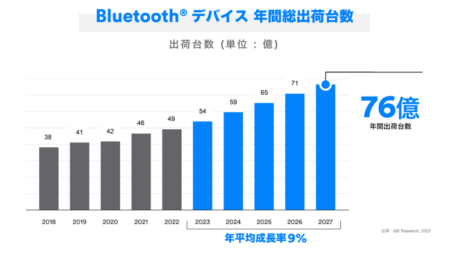 Bluetooth規格の標準化団体であるBluetooth SIG (Special Interest Group)は、Bluetooth®技術の仕様策定、デバイスの認証テスト、技術の普及推進によって、業界をリードする世界中の企業を支えています。4万社を超えるメンバー企業を擁する非営利業界団体として、メンバーとともに、さまざまな市場およびソリューションにわたりBluetooth技術の推進に取り組んでいます。
Bluetooth規格の標準化団体であるBluetooth SIG (Special Interest Group)は、Bluetooth®技術の仕様策定、デバイスの認証テスト、技術の普及推進によって、業界をリードする世界中の企業を支えています。4万社を超えるメンバー企業を擁する非営利業界団体として、メンバーとともに、さまざまな市場およびソリューションにわたりBluetooth技術の推進に取り組んでいます。
Bluetooth製品の全世界での年間総出荷台数はメンバー企業全体で50億台を超え、今後も拡大が続くと予測されます。2027年には年間出荷台数が76億台に達すると予測され、年平均成長率(CAGR)は 9%です。
市場への大きな影響が見込まれるBluetooth®︎技術の新しい主要ユースケースとして、Auracast™ ブロードキャスト オーディオ、電子棚札(ESL)、アンビエントIoTがあります。
Auracast™ ブロードキャスト オーディオ
過去20年以上にわたり、Bluetooth®技術はワイヤレスオーディオに幅広い種類のイノベーションを実現し、オーディオに変革をもたらし、私たちのメディアの楽しみ方、そして世界を体験する方法に革命的な変化をもたらしてきました。LE Audioは、Bluetoothの新しい柔軟なアーキテクチャとして、今後20年にわたるオーディオにおける技術革新を支えていきます。LE Audioは以下のように、今日の市場が抱える課題の改善に役立つ機能強化を数多くもたらします。
- 製品性能の向上(高音質、高性能、低消費電力)
- 新しい標準規格、性能向上、グローバルな相互運用性に支えられたBluetooth補聴器の普及
- ブロードキャストオーディオ機能の追加、および公共の場へのAuracast™ ブロードキャスト オーディオの導入
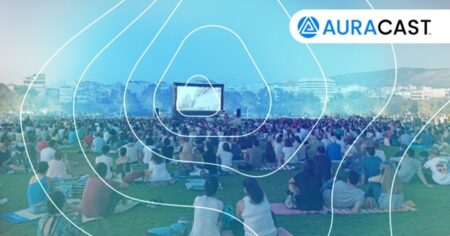
Auracast™ ブロードキャスト オーディオは画期的なオーディオ体験を可能にして豊かな音の世界を実現する、新しいBluetooth®機能です。これによってもたらされる体験は、従来のペアリングとは異なります。Auracast™ ブロードキャスト オーディオでは、送信機(スマートフォン、タブレット、パソコン、公共施設の送信機)から受信範囲内にある受信機(イヤホンやヘッドホンなど)に対し、受信機の台数に制限なくオーディオ信号を配信できます。
送信機からは公開での配信が可能で、受信者の数に制限はありません。また、Auracast™配信を聴くためにスマートフォンは必須ではありません。Auracast™配信は暗号化してパスワードで保護することももちろん可能ですが、多くの場合、特に公共の場ではすべての人に公開された形で配信が行われることになるでしょう。
Auracast™ ブロードキャスト オーディオで実現される体験は主に3つあります。
- オーディオの共有: スマートフォン、タブレット、ノートパソコンやその他同種の機器を使用して周囲の人とオーディオを共有し、それぞれが自身のイヤホンやヘッドホンを使用しながら、同じ音楽や動画を同時に視聴できます。音声によるツアーガイドシステムなど、1つの音源から複数の人のイヤホンやヘッドホンに音声を配信する形での、グループでの活用も可能です。
- ミュートを解除: バーやジム、待合室、空港その他の公共の場にある無音テレビの音を聴くことが可能になります。Auracast™ ブロードキャスト オーディオがあれば、無音で見る(字幕を読む)のではなく、番組・テレビからの音声配信を受信し視聴できます。
- 最高の音で聞く: 公共の場での周囲からの雑音・騒音は音声を聞き取り難くしますが、難聴者にとって大きな問題です。Auracast™ ブロードキャスト オーディオでは、自身のオーディオ機器や補聴器を使って場内放送などの音声を直接聞くことができ、最善の聞こえを実現します。この活用方法には、劇場での拡張オーディオ体験や、礼拝施設・公共交通拠点・空港・会議場など、人が集まる場所での聴覚補助への活用が考えられます。また、複数言語で同時配信する多言語対応にも使用できます。
当然ながら、世界中のあらゆる公共の場がAuracast™ ブロードキャスト オーディオに対応するまでには時間が必要です。この革新的な新しいオーディオ技術が完全に普及するには数年はかかるでしょう。しかしながら、予想されるLE Audioの採用率や活用範囲、およびAuracast™ ブロードキャスト オーディオのユースケースはかなりの規模に及びます。
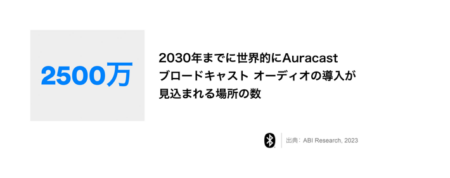 ABI Researchでは、今後5年以内にLE Audio対応製品の年間出荷台数が30億台を超え、今後5年間で出荷されるスマートフォンの90%がLE Audioに対応すると予測しています。これは、現在では100%のスマートフォンが対応している無線通信規格であるBluetooth® LEの登場初期の状況に一致しています。
ABI Researchでは、今後5年以内にLE Audio対応製品の年間出荷台数が30億台を超え、今後5年間で出荷されるスマートフォンの90%がLE Audioに対応すると予測しています。これは、現在では100%のスマートフォンが対応している無線通信規格であるBluetooth® LEの登場初期の状況に一致しています。
ABI Researchはまた、Auracast™ ブロード キャスト オーディオの利点を享受し活用できる施設は現在でも世界に6,100万カ所以上存在すると推計しています。トレンドを把握するには未だ時期尚早ですが、今後5年から7年の間に、Auracast™ ブロードキャスト オーディオが導入される場所の数は約250万カ所にのぼるとのアナリスト予測も示されています。こうした予測について、詳しくは、LE Audio:Bluetoothオーディオの未来をダウンロードしてご覧ください。
Bluetooth電子棚札(ESL)
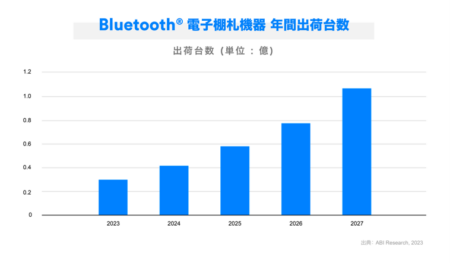 Bluetooth®︎ ESLは、巨大な市場へと成長する可能性を持つこの分野に、Bluetooth® コア仕様の最新版と電子棚札(ESL)用のプロファイルおよびサービスに支えられた高セキュリティ・大規模・低消費電力のソリューションを提供します。
Bluetooth®︎ ESLは、巨大な市場へと成長する可能性を持つこの分野に、Bluetooth® コア仕様の最新版と電子棚札(ESL)用のプロファイルおよびサービスに支えられた高セキュリティ・大規模・低消費電力のソリューションを提供します。
ESLは小売業者の経営および資源管理の改善を支援し、大手小売企業では標準化と相互運用性を推進しています。現在のソリューションではサブGHz、2.4GHz、赤外線など各社の独自技術が混在して使用されています。Bluetooth® ESLはESL初の標準規格であり、大手小売業における要件を考慮しながら大手ESLベンダーと協力して策定されました。
ESLのTAM(獲得可能な最大市場規模)は約60億台と推定されています。アナリストはBluetooth対応ESLの年間総出荷数が2027年まで毎年1億台を超えると予想しています。しかし、現実にはこの予想を上回る可能性もあります。
Bluetooth®︎ ESLの機運は迅速に高まると予想されます。ESL市場は大手サプライヤーがひしめく狭いエコシステムであり、技術的な優先度は、数百の店舗を抱え何百万台ものESLを購入する可能性のある大手小売企業によって牽引されています。大手小売企業は標準化を求め、その動きを推進しています。
最近では、SES-Imagotag(Bluetooth®︎ ESLの標準化に影響力を与えた主要企業の1つ)が、米国スーパーマーケットのWalmartとの連携における次のステップを発表 しました。この発表には、今後12カ月から18カ月の間にBluetooth®︎ ESLがWalmartの約500店舗に展開されるとの内容が含まれています。電子棚札の数にすると約6,000万枚が、この期間中に設置されることになります。
Bluetooth®︎技術とアンビエントIoT
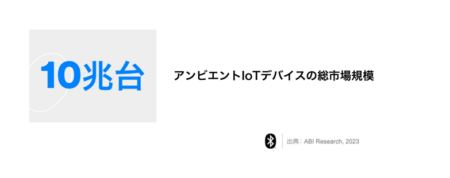
アンビエントIoTが意味するものはさまざまです。Bluetooth SIGにとってのアンビエントIoTは、Bluetooth®︎ LEの使用が拡大を続け、ほぼ全てのものを対象とするリアルタイムの広範なIoT接続に対応していくという、過去10年にわたる動きの結実です。そのTAM(獲得可能な最大市場規模)の総計は兆単位に上り、各種市場予測を完全に覆すと見られます。
低コスト・環境発電駆動のタグが可能にするアンビエントIoTデバイスは、あらゆるデバイスの位置や状況、状態をトラッキングでき、サプライチェーンの大幅な改善を目的としています。初期段階では、食品、薬品、製造など期限のある商品や返品可能な資産を多く扱う高速サプライチェーンを中心としています。Bluetooth®技術は標準化された低消費電力のソリューションによってアンビエントIoTの要件を満たすことが可能であり、この分野を牽引する最善の位置を占めています。
ABI Researchによると、世界の食料の30%は無駄にされています。また、Locatibleによる推定によれば、医薬品・ヘルスケア・製造業全体では年間最大20%の医療機器・医療品が紛失し、機器を探すために最大30%の時間が費やされています。こうした問題に対して、アンビエントIoTソリューションは、有望な解決策となり得ます。この技術を活用することで、無駄の削減と業務効率の向上が可能になります。
この分野におけるBluetooth®︎技術に関する予測は、すでに大きな規模に及んでいます。アンビエントIoTに関してはワイヤレスタグの受注量は億単位、位置情報サービス機器の今後5年における年間出荷台数は5億台規模が続き、2027年には現在の2.5倍になると見込まれます。
アンビエントIoTは市場予測を完全に覆すと見られます。この分野の低消費電力・ 電池不要のタグについては、将来的に、市場動向を把握するための新しい方法が必要となるでしょう。
Bluetooth®︎に関する市場予測や技術トレンドについて詳しくは、2023年Bluetooth®︎市場動向をご覧ください。

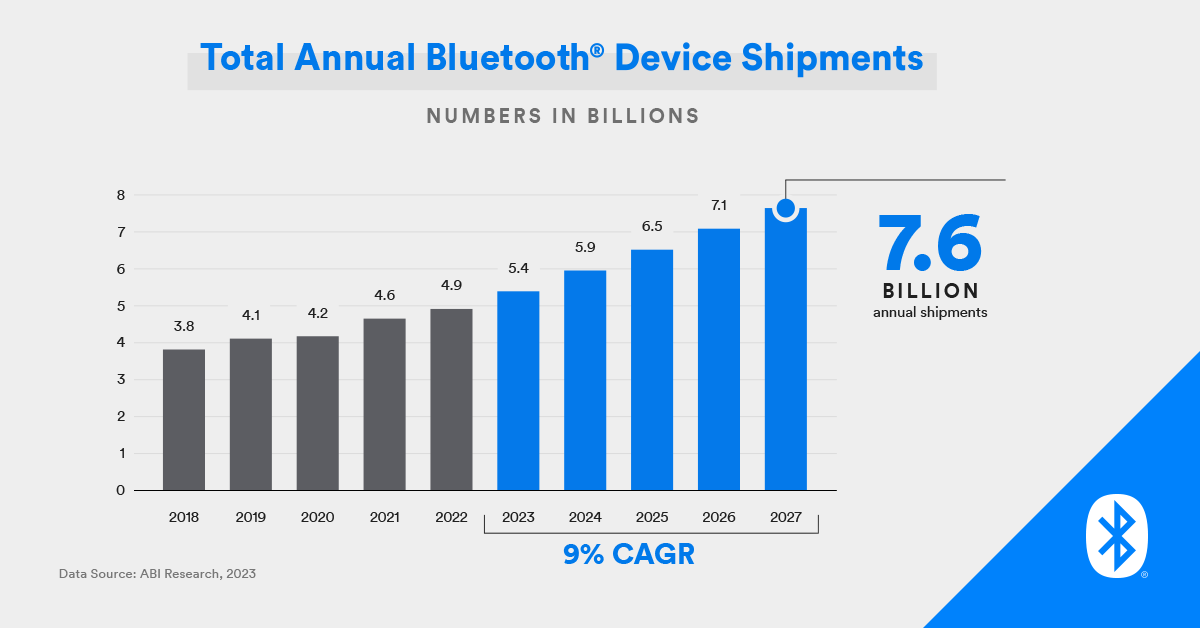
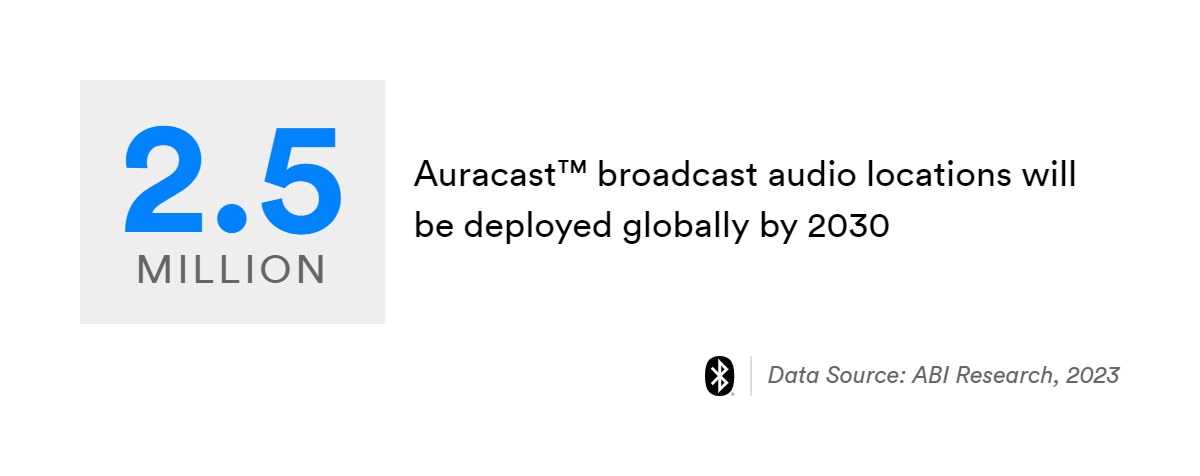
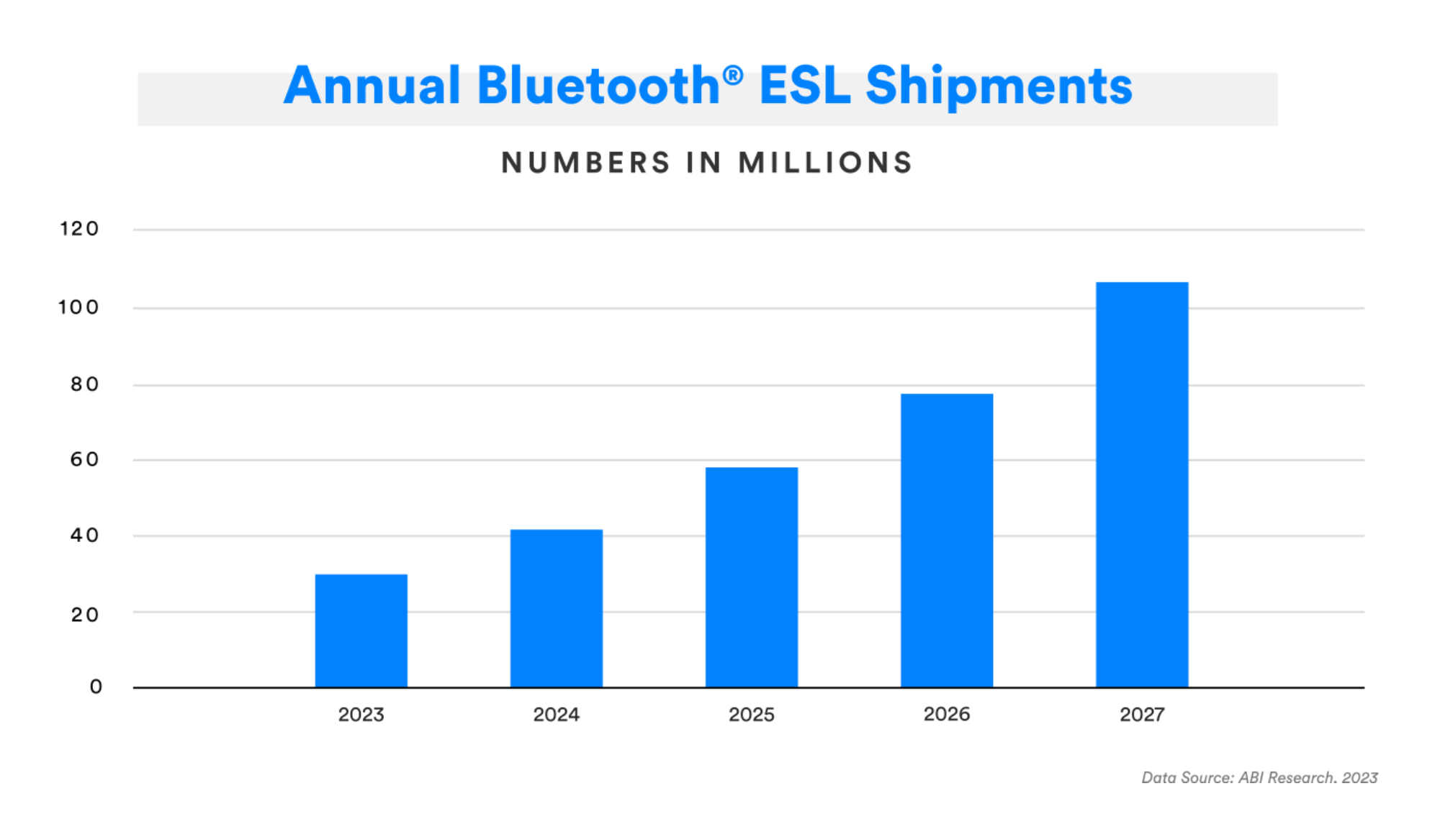
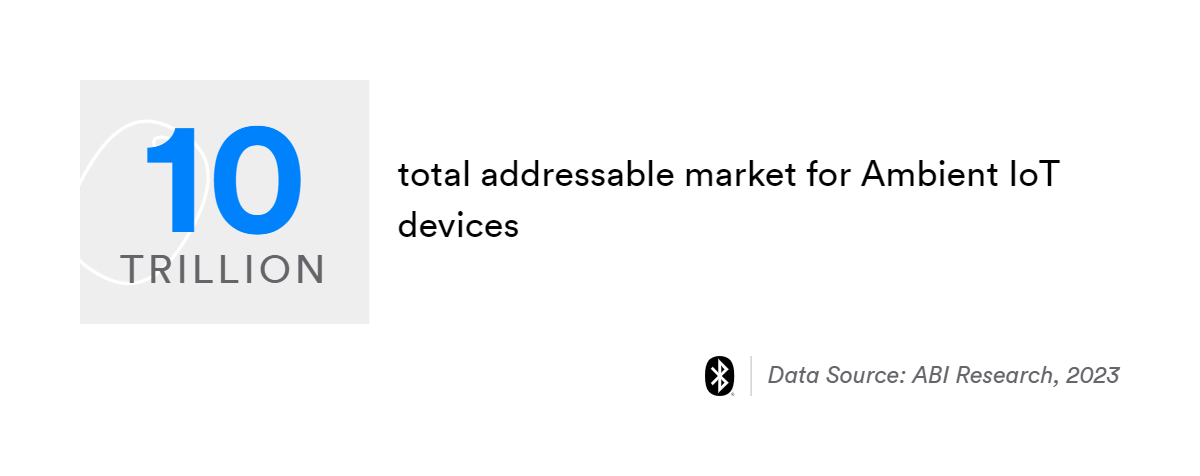
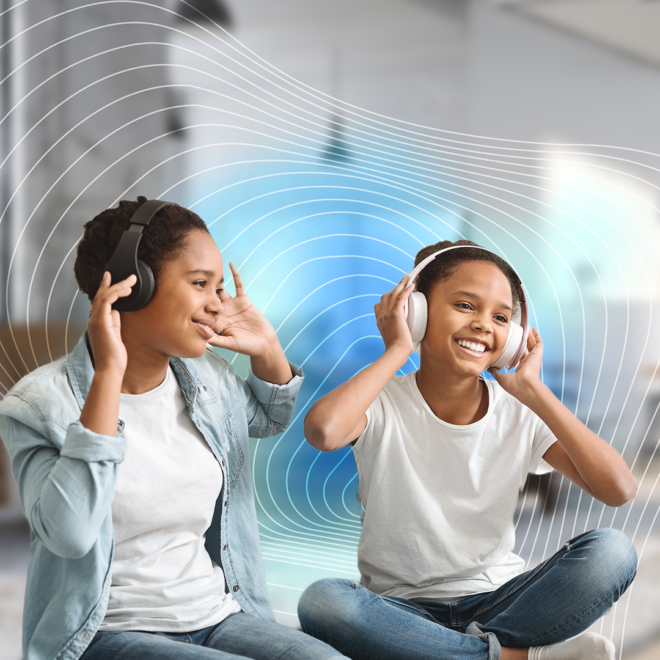
![Forbes Predictions article 72 dpi 1300 x 680 px 768x402[1]](https://www.bluetooth.com/wp-content/uploads/2024/04/Forbes-Predictions-article-72-dpi-1300-x-680-px-768x4021-1-660x345.png)
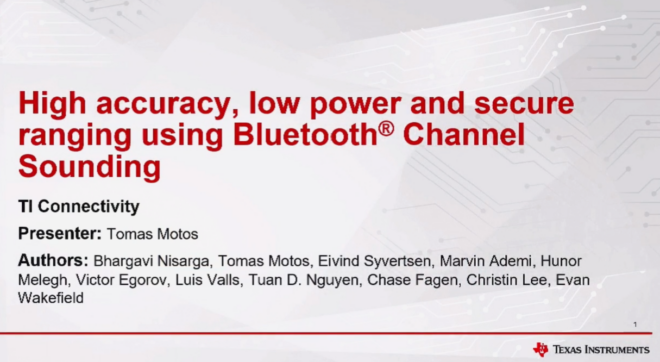
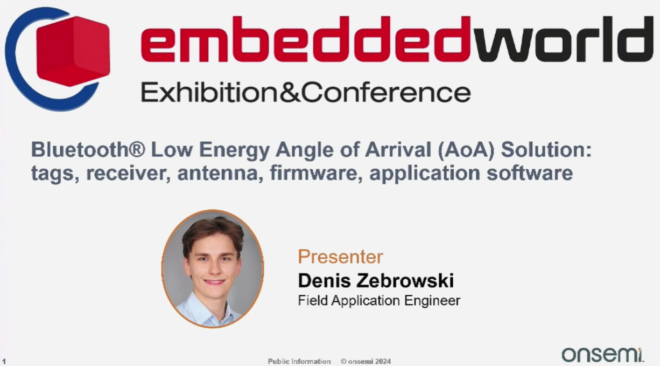
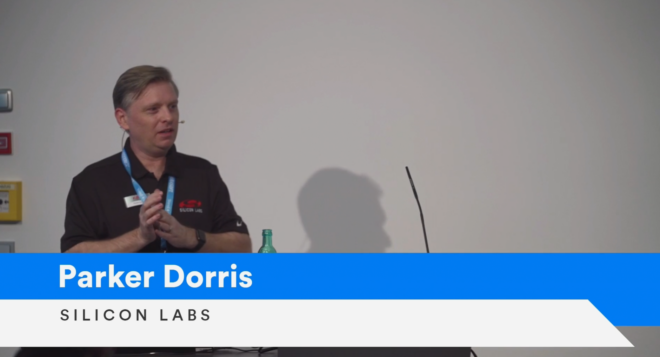

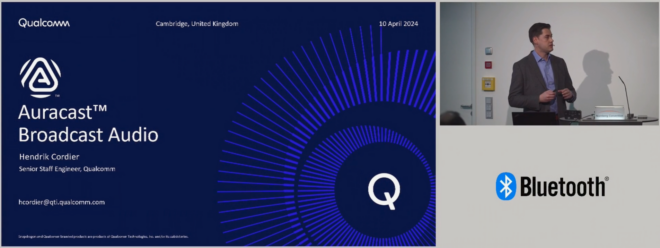

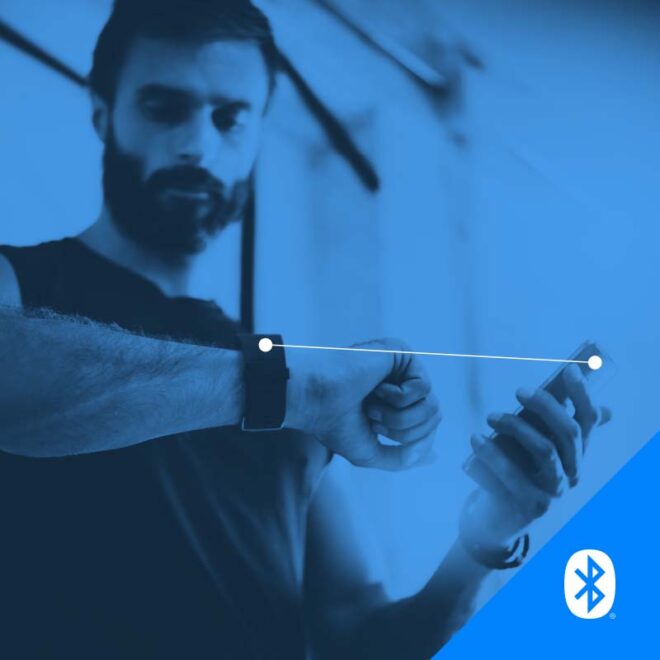
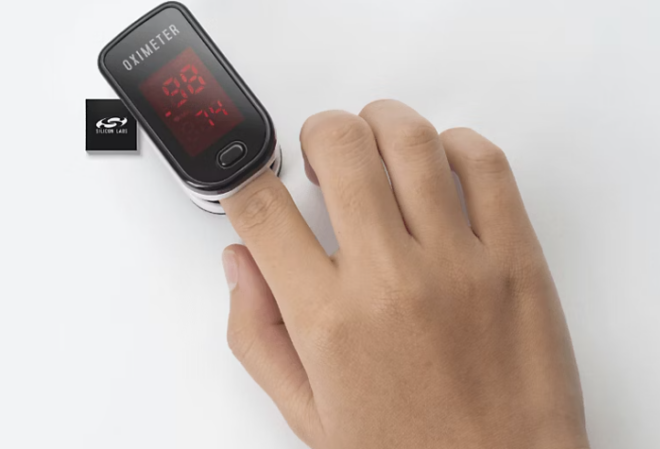

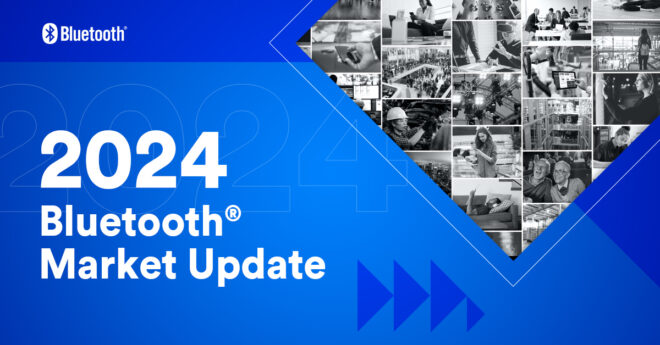
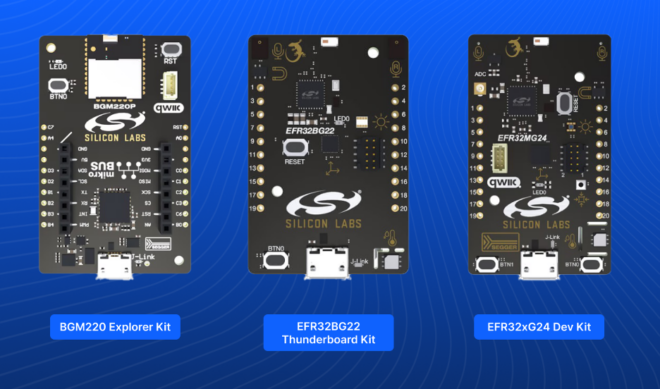
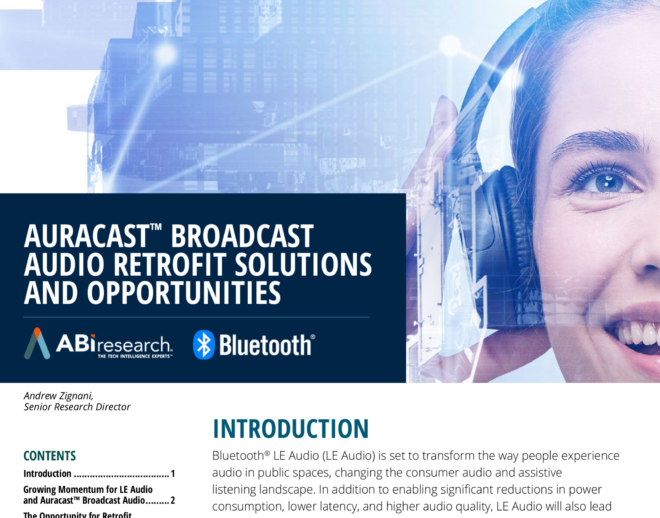
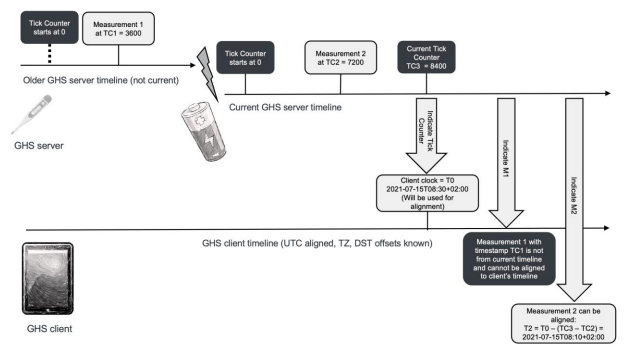
![ABI Growth Chart.png 815076338[1]](https://www.bluetooth.com/wp-content/uploads/2024/03/ABI_Growth_Chart.png_8150763381-660x384.png)
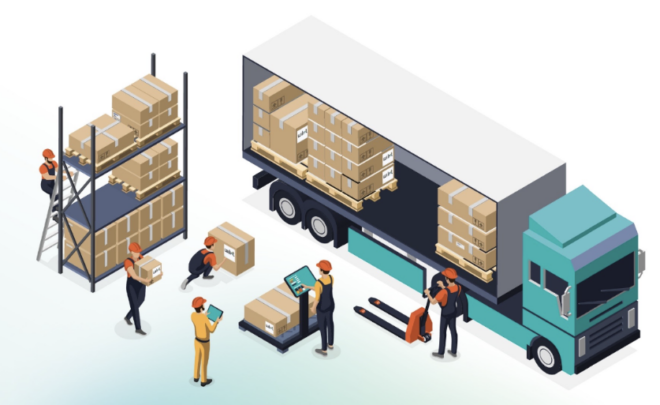
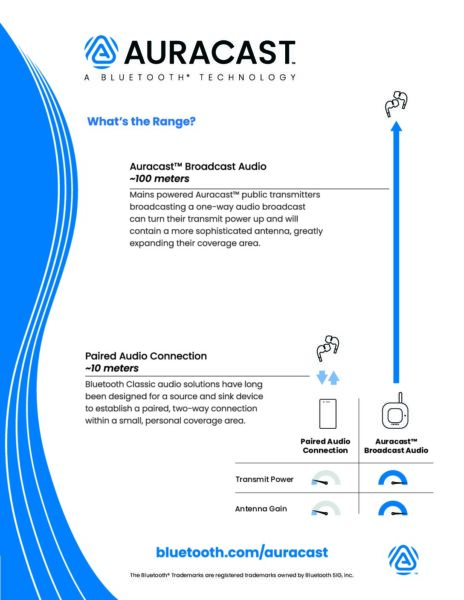
![2312 CES Handout Images FINAL existing pdf 464x600[1]](https://www.bluetooth.com/wp-content/uploads/2024/01/2312_CES_Handout-Images_FINAL-existing-pdf-464x6001-1.jpg)
![2312 CES Handout Images FINAL unlimited pdf 464x600[1]](https://www.bluetooth.com/wp-content/uploads/2024/01/2312_CES_Handout-Images_FINAL-unlimited-pdf-464x6001-1.jpg)
